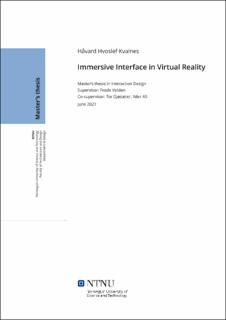| dc.contributor.advisor | Volden, Frode | |
| dc.contributor.advisor | Gjøsæter, Tor | |
| dc.contributor.author | Kvalnes, Håvard Hvoslef | |
| dc.date.accessioned | 2021-09-14T17:01:53Z | |
| dc.date.available | 2021-09-14T17:01:53Z | |
| dc.date.issued | 2021 | |
| dc.identifier | no.ntnu:inspera:81988689:35738333 | |
| dc.identifier.uri | https://hdl.handle.net/11250/2776856 | |
| dc.description.abstract | I dette studiet undersøkte me i kva stor grad tradisjonelt brukargrensesnitt bør endrast for å skapa ein så innlevande oppleving som mogleg i virtuell røyndom (VR). Meir spesifikt såg studien på førsteperson skytespel (FPS). Målet var å gje spelaren så mykje informasjon dei trong i spelet, samtidig som det gjekk minst mogleg ut over innlevinga deira. For å få til dette vart det produsert prototypar der deltakaren var plassert i ein skytebane i VR og testa forskjellige variantar ein kunne vise status på ammunisjon til brukaren. Det vart gjennomført ein fenomenologisk studie ved hjelp av observasjon av deltakarane og ustrukturerte intervju for å forstå deira synspunkt når dei prøvde prototypane. I tillegg til den fenomenologiske studien vart det gjort ein analyse av eksisterande VR FPS-spel for å sjå korleis dei mest kjende spela gjer det same. Resultatet av dette prosjektet er nokre retningslinjer som speldesignarar og -utviklarar kan nytte seg av i design- og utviklingsfasa for å skape eitt brukargrensesnitt som gjev mest mogleg kjensle av innleving i sine VR-applikasjonar. | |
| dc.description.abstract | This project investigated to which degree traditional interface should be altered to create as immersive an experience as possible in a virtual reality (VR) environment, more specifically in first person shooter (FPS) games. The aim was to give the player as much in-game information as they required, while still creating an immersive experience for them. To do this, prototypes were created where the participant were placed in a VR shooting range, and different ways of displaying the ammunition status to the user were tested. A phenomenological study was conducted by observing the participants, and conducting unstructured interviews to understand their point of view when testing the prototypes. In addition to the phenomenological study, a content analysis on state-of-the-art VR FPS games was done to investigate how the most acclaimed games do the same. The result of the project is guidelines for immersive interface in VR that game designers and developers can use in their design and development stages for VR applications. | |
| dc.language | eng | |
| dc.publisher | NTNU | |
| dc.title | Immersive Interface in Virtual Reality | |
| dc.type | Master thesis | |
